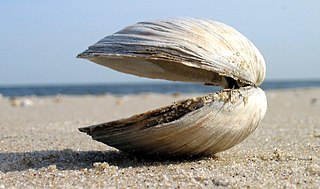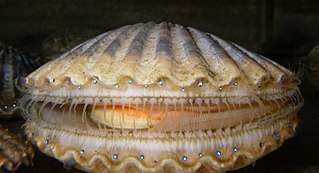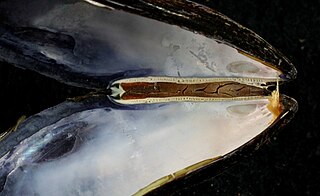A hinge is a mechanical bearing that connects two solid objects.
Contents
- Arts, entertainment, and media
- Science and mathematics
- People
- Places
- Types of hinge
- Other uses
- See also
Hinge or hinges can also refer to:
A hinge is a mechanical bearing that connects two solid objects.
Hinge or hinges can also refer to:

Clam is a common name for several kinds of bivalve molluscs. The word is often applied only to those that are edible and live as infauna, spending most of their lives halfway buried in the sand of the seafloor or riverbeds. Clams have two shells of equal size connected by two adductor muscles and have a powerful burrowing foot. They live in both freshwater and marine environments; in salt water they prefer to burrow down into the mud and the turbidity of the water required varies with species and location; the greatest diversity of these is in North America.

A seashell or sea shell, also known simply as a shell, is a hard, protective outer layer usually created by an animal or organism that lives in the sea. The shell is part of the body of the animal. Empty seashells are often found washed up on beaches by beachcombers. The shells are empty because the animal has died and the soft parts have decomposed or been eaten by another animal.

Bivalvia, in previous centuries referred to as the Lamellibranchiata and Pelecypoda, is a class of marine and freshwater molluscs that have laterally compressed bodies enclosed by a shell consisting of two hinged parts. As a group, bivalves have no head and they lack some usual molluscan organs, like the radula and the odontophore. The class includes the clams, oysters, cockles, mussels, scallops, and numerous other families that live in saltwater, as well as a number of families that live in freshwater. The majority are filter feeders. The gills have evolved into ctenidia, specialised organs for feeding and breathing. Most bivalves bury themselves in sediment, where they are relatively safe from predation. Others lie on the sea floor or attach themselves to rocks or other hard surfaces. Some bivalves, such as the scallops and file shells, can swim. Shipworms bore into wood, clay, or stone and live inside these substances.

A hinge is a mechanical bearing that connects two solid objects, typically allowing only a limited angle of rotation between them. Two objects connected by an ideal hinge rotate relative to each other about a fixed axis of rotation, with all other translations or rotations prevented; thus a hinge has one degree of freedom. Hinges may be made of flexible material or moving components. In biology, many joints function as hinges, such as the elbow joint.

Scallop is a common name that encompasses various species of marine bivalve mollusks in the taxonomic family Pectinidae, the scallops. However, the common name "scallop" is also sometimes applied to species in other closely related families within the superfamily Pectinoidea, which also includes the thorny oysters.
Freshwater bivalves are one kind of freshwater mollusc, along with freshwater snails. They are bivalves that live in fresh water as opposed to salt water, which is the main habitat type for bivalves.
A valve is each articulating part of the shell of a mollusc or another multi-shelled animal such as brachiopods and some crustaceans. Each part is known as a valve or in the case of chitons, a "plate". Members of two classes of molluscs, the Bivalvia (clams) and the Polyplacophora (chitons), have valves.

A bivalve shell is part of the body, the exoskeleton or shell, of a bivalve mollusk. In life, the shell of this class of mollusks is composed of two hinged parts or valves. Bivalves are very common in essentially all aquatic locales, including saltwater, brackish water, and freshwater. The shells of bivalves commonly wash up on beaches and along the edges of lakes, rivers, and streams. Bivalves by definition possess two shells or valves, a "right valve" and a "left valve", that are joined by a ligament. The two valves usually articulate with one another using structures known as "teeth" which are situated along the hinge line. In many bivalve shells, the two valves are symmetrical along the hinge line—when truly symmetrical, such an animal is said to be equivalved; if the valves vary from each other in size or shape, inequivalved. If symmetrical front-to-back, the valves are said to be equilateral, and are otherwise considered inequilateral.

Juliidae, common name the bivalved gastropods, is a family of minute sea snails, marine gastropod mollusks or micromollusks in the superfamily Oxynooidea, an opisthobranch group.
Phaxas pellucidus, the transparent razor shell, is a species of marine bivalve mollusc in the family Pharidae. It is found buried in the seabed in coastal waters of northwest Europe, often in great numbers.
Concavodonta is an extinct genus of early bivalve in the extinct family Praenuculidae. The genus is one of three genera in the subfamily Concavodontinae. Concavodonta is known solely from late Ordovician, Caradoc epoch, fossils found in Europe and South America. The genus currently contains three accepted species, Concavodonta imbricata, Concavodonta ovalis and the type species Concavodonta ponderata.
Villicumia is an extinct genus of bivalve in the extinct family Praenuculidae. The genus is one of eleven genera in the subfamily Praenuculinae. It is one of three Praenuculinae genera known solely from late Ordovician, Caradoc epoch, fossils found in South America. Villicumia currently contains a single accepted species, Villicumia canteraensis.

Hinge teeth are part of the anatomical structure of the inner surface of a bivalve shell, i.e. the shell of a bivalve mollusk. Bivalves by definition have two valves, which are joined together by a strong and flexible ligament situated on the hinge line at the dorsal edge of the shell. In life, the shell needs to be able to open slightly to allow the foot and siphons to protrude, and then close again, without the valves moving out of alignment with one another. To make this possible, in most cases the two valves are articulated using an arrangement of structures known as hinge teeth. Like the ligament, the hinge teeth are also situated along the hinge line of the shell, in most cases.

A resilifer is a part of the shell of certain bivalve mollusks. It is either a recess or a process, the function of which is the attachment of an internal ligament, which holds the two valves together.

A hinge ligament is a crucial part of the anatomical structure of a bivalve shell, i.e. the shell of a bivalve mollusk. The shell of a bivalve has two valves and these are joined by the ligament at the dorsal edge of the shell. The ligament is made of a strong, flexible and elastic, fibrous, proteinaceous material which is usually pale brown, dark brown or black in color.

Abductin is a naturally occurring elastomeric protein found in the hinge ligament of bivalve mollusks. It is unique as it is the only natural elastomer with compressible elasticity, as compared to resilin, spider silk, and elastin. Its name was proposed from the fact that it functions as the abductor of the valves of bivalve mollusks.

The adductor muscles are the main muscular system in bivalve mollusks. In many parts of the world, when people eat scallops, the adductor muscles are the only part of the animal which is eaten. Adductor muscles leave noticeable scars or marks on the interior of the shell's valves. Those marks are often used by scientists who are in the process of identifying empty shells to determine their correct taxonomic placement.

In anatomy, a resilium is part of the shell of certain bivalve mollusks. It is an internal ligament, which holds the two valves together and is located in a pit or depression known as the resilifer.

A shell purse is a type of coin purse that is made from whole or trimmed mollusk shells, especially from bivalve mollusc shells. These purses are of mainly novelty use and purchased as souvenirs of visits, etc. In the past, some were engraved or painted with floral or other decorations, sentimental messages, personal or place names. In many cases there was extra working of the shell, either grinding down and polishing to expose the mother of pearl or filing to form patterns such as criss-cross designs.
Pinctada fucata, the Akoya pearl oyster (阿古屋貝), is a species of marine bivalve mollusk in the family Pteriidae, the pearl oysters. Some authorities classify this oyster as Pinctada fucata martensii. It is native to shallow waters in the Indo-Pacific region and is used in the culture of pearls.